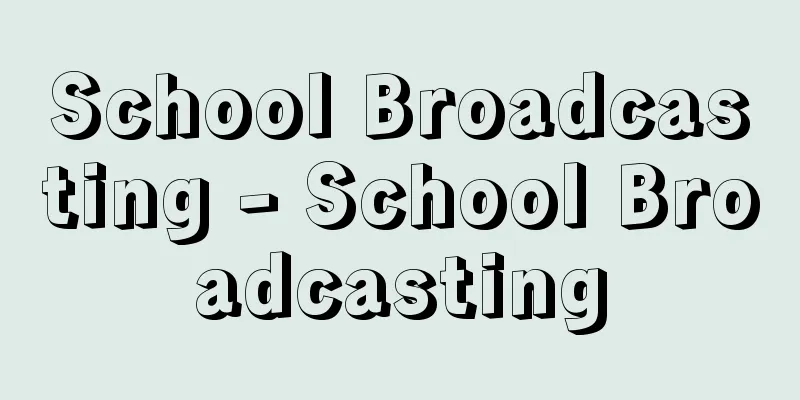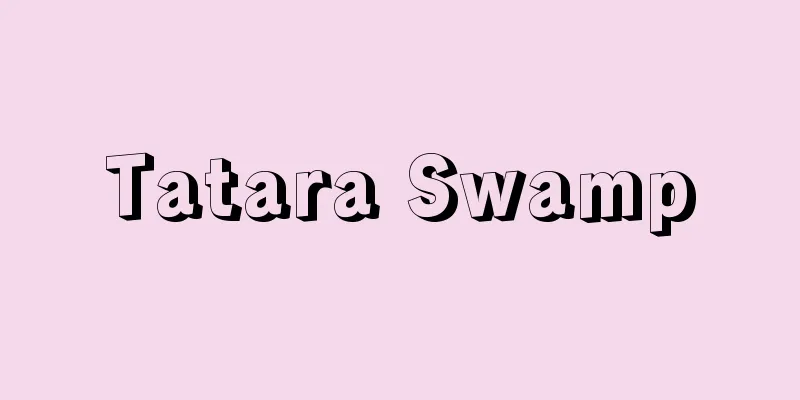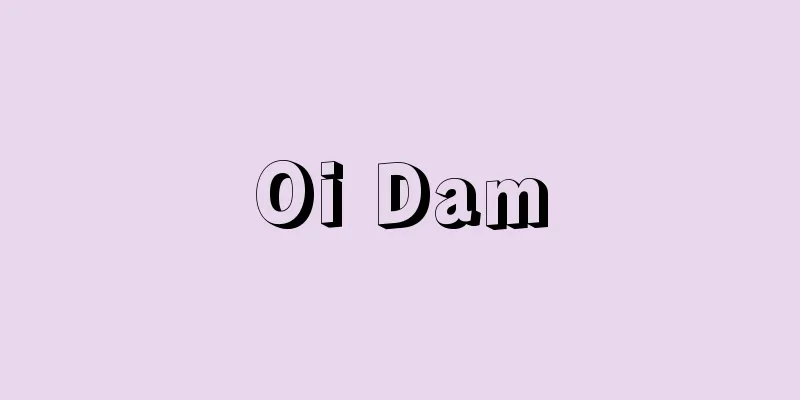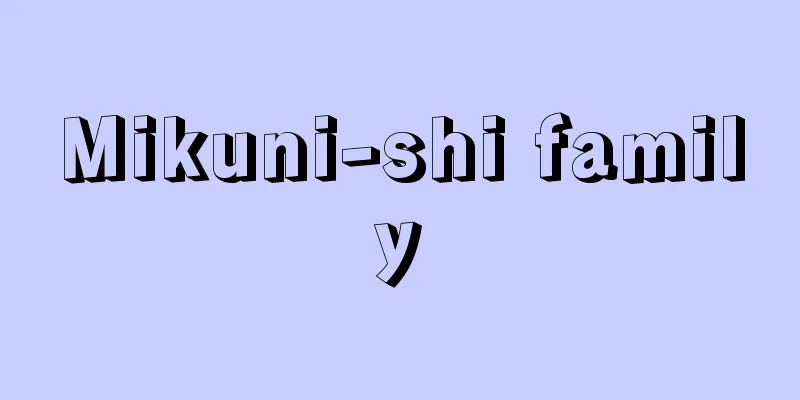School Broadcasting - School Broadcasting

|
School broadcasting is a type of educational broadcasting, and refers to the broadcasting of programs for children and students to watch under the guidance of teachers in accordance with the educational curriculum standards set out in laws and regulations related to school education, as well as programs for teachers that contribute to the improvement and enhancement of teachers' learning methods, life guidance methods, school management methods, etc. Therefore, it generally refers to broadcasts related to school education by the public broadcasting organization, Japan Broadcasting Corporation (NHK), and private broadcasting organizations (commercial broadcasters), which are general broadcasting operators. However, since the 1960s, advances and developments in electronic and mechanical technology have made it possible for schools to independently produce and broadcast programs in line with the theory and practice of broadcasting education, and some schools also consider school broadcasting to include such school broadcasts. [Shinohara Fuyoji] HistoryThe first school broadcasts in Japan were made by NHK's Osaka Central Broadcasting Station in 1933 (Showa 8), and included radio exercises, music, and lectures for teachers aimed at elementary school students. Nationwide school broadcasting began in 1935 with radio broadcasts by NHK Tokyo Central Station, also aimed at elementary schools. There was a temporary halt in 1945 due to the intensification of the Pacific War, but in 1953 (Showa 28), it was transferred to Radio 2 Station, and school broadcasting began by television, and has continued to this day, making use of the broadcasting characteristics of each medium. However, (1) with the transition to an information and communication society represented by multimedia and the Internet, it is said that television is moving toward digitalization and computers toward imaging, and the boundary between broadcasting and communication is becoming blurred, and we are now in an environment where high-quality digitized video information can be easily used, and (2) there is a diversification and change in values regarding the content and methods of education and learning that are not limited to existing school broadcasts, such as the use of general broadcasts related to daily life, and so on. This calls for a review of the production, organization, and use of school broadcasting programs. On the other hand, school broadcasting by commercial broadcasters was started by Nippon Educational Television (now TV Asahi) in 1959, and since then Nippon Television, Fuji Television and others have organized their own school broadcasting programs, but all of them are programs aimed at young children. In addition, the 102 UHF-only stations nationwide (as of December 2001) are also putting effort into school broadcasting that is suited to the local conditions, with the expectation of new collaboration. [Shinohara Fuyoji] Educational FeaturesResearch conferences on broadcasting education, especially the activities of the Japan Society for Broadcasting Education (now the Japan Society for Educational Media Studies), which was founded in 1954, along with the National Conference on Broadcasting Education which began in 1950, have provided an excellent forum for resolving various problems in modern education through theoretical foundations and practical research on school broadcasting, and have also helped to enhance the functions of school broadcasting, such as ensuring equal educational opportunities and correcting educational disparities due to regional differences. [Shinohara Fuyoji] Utilization rateAccording to a 2000 survey by the NHK Broadcasting Culture Research Institute, the trends in the rate of use of TV school broadcasts in elementary schools, the rate of color television penetration, the rate of video tape recorder (VTR) penetration, and the number of schools connected to the Internet are as shown in . Since the mid-1990s, there has been a rapid spread of the Internet to schools, while the use of TV school broadcasts has been gradually declining since peaking in 1986. It is also known that VTR penetration in schools is high. According to a 1998 survey of durable consumer goods conducted by the Management and Coordination Agency (now the Ministry of Internal Affairs and Communications), VTRs have the third highest penetration rate in ordinary households, after room air conditioners, passenger cars, and microwave ovens, which suggests a change in lifestyle and viewing patterns, with people now recording and watching programs. Even in schools, where the penetration rate of VTRs is high, the idea of broadcast use, such as "live broadcasts, full-length, continuous viewing," is gradually changing. Changes in social and family life due to the rapid development of new visual information and communication media, represented by multimedia and the Internet, are having a major impact not only on the use of school broadcasting but also on its production and programming, calling for urgent responses from both receivers and senders of broadcasts. [Shinohara Fuyoji] "Research on the History of School Broadcasting in Japan" by Takeo Isobe (1999, Hokuju Publishing)" ▽ "NHK Broadcasting Culture Research Institute, ed., "Broadcasting Research and Surveys" (2001, Japan Broadcasting Publishing Association)" [References] | | | | | | |The figure shows the trends in the rate of NHK school television broadcast usage, the rate of color television penetration, the rate of VTR penetration, and the number of schools with Internet access (100% = all schools). Note: From the NHK Broadcasting Culture Research Institute's 2000 survey. ©Shogakukan School broadcasting usage rate (elementary schools) [Figure] Source: Shogakukan Encyclopedia Nipponica About Encyclopedia Nipponica Information | Legend |
|
学校放送とは、教育放送の一つであり、学校教育に関する法令に定められた教育課程の基準に準拠して、教師の指導のもとに視聴させる児童・生徒向けの番組と、教師の学習指導法、生活指導法、学校管理法などの改善・向上に寄与するような教師向けの番組を放送する営みをいう。 したがって、一般には、公共放送事業体である日本放送協会(NHK)や一般放送事業者である民営放送機関(民放)の学校教育に関する放送を意味する。しかし、1960年代以来の電子・機械技術の進歩と発展が、放送教育の理論や実践に伴う学校での自主的な番組制作や放送を可能にしていることもあり、このような校内放送も含めて、学校放送をとらえる考え方もある。 [篠原文陽児] 沿革日本の学校放送は、1933年(昭和8)のNHK大阪中央放送局によるラジオ放送がその初めであり、小学校を対象としたラジオ体操、音楽、教師のための講座などであった。 全国的規模の学校放送の開始は、1935年のNHK東京中央放送局による、同じく小学校を対象としたラジオ放送である。その後、45年に太平洋戦争激化のための一時的中断があったが、53年(昭和28)のラジオ第2放送局への移行と、テレビジョンによる学校放送の開始で、それぞれのメディアの放送特性を生かし、今日まで継続されている。しかし、(1)マルチメディアやインターネットに代表される情報通信社会への移行のなかで、テレビはデジタル化へコンピュータは映像化へ向かうといわれているように、放送と通信の境界が判然としなくなり、デジタル化された高品質の映像情報が容易に利用できる環境になってきていること、(2)日常生活に関連した一般放送を利用するなど、既存の学校放送にとらわれない、教育や学習の内容と方法に関する価値観の多様化と変化があること、などから学校放送番組の制作、編成および利用に関して、見直しが求められている。 一方、民放による学校放送は、1959年、日本教育テレビ(現テレビ朝日)が着手し、その後、日本テレビ、フジテレビなどが独自の学校放送を編成しているが、いずれも幼児向け番組である。また、全国102社(局)あるUHF専用局(2001年12月現在)も、新たな連携が期待される地域の実態に即した学校放送に力を入れている。 [篠原文陽児] 教育機能放送教育に関する研究大会、とくに、1954年(昭和29)設立の「日本放送教育学会(現・日本教育メディア学会)」の活動は、1950年(昭和25)から始まった「放送教育全国大会」とともに、学校放送の理論的基盤や実践研究を通じた、現代教育の諸問題を解決するよい場となっており、また、教育の機会均等や地域差による教育の不均衡を是正するという、学校放送のもつ機能を高めるのに役だっている。 [篠原文陽児] 利用率NHK放送文化研究所の2000年度調査によれば、小学校のテレビ学校放送利用率、カラーテレビ普及率、ビデオテープレコーダー(VTR)普及率、インターネット接続校の推移はにみられるとおりである。1990年代なかば以降、学校へのインターネットの急速な普及がある一方、テレビ学校放送の利用は1986年をピークに徐々にではあるが減少する傾向にある。学校へのVTR普及率も高いことが知られている。98年度の総務庁(現総務省)による耐久消費財調査によれば、一般家庭においても、ルームエアコン、乗用車、電子レンジに次いで普及率が高く、録画して番組を視聴する生活や視聴様式の変化を類推することができる。VTRの普及率が高い学校等でも、「生(なま)放送・まるごと・継続視聴」という放送利用の考え方が少しずつではあるが変化してきている。 マルチメディアとインターネットに代表される新しい映像情報や通信媒体の急速な発展に伴う社会生活と家庭生活の変化は、学校放送の利用のみならず、制作と編成にも大きな影響を与え、放送の受け手と送り手の両者に早急な対応を求めつつある。 [篠原文陽児] 『磯辺武雄著『わが国の学校放送史の研究』(1999・北樹出版)』▽『NHK放送文化研究所編『放送研究と調査』(2001・日本放送出版協会)』 [参照項目] | | | | | | |図は、NHKテレビ学校放送利用率、カラーテレビ普及率、VTR普及率、インターネット接続校の推移を示す(100%=全学校)注:NHK放送文化研究所2000年度調査より©Shogakukan"> 学校放送利用率(小学校)〔図〕 出典 小学館 日本大百科全書(ニッポニカ)日本大百科全書(ニッポニカ)について 情報 | 凡例 |
<<: School Health Law - gakkohokenho
>>: School Library Law - Gakko Toshokanho
Recommend
American Hibiscus - American Hibiscus
A perennial plant of the Hibiscus genus (Malvacea...
Prince Takehito
Year of death: July 5, 1913 Year of birth: Bunkyu ...
Imagawa clan's personal seal and signature document
...From the perspective of the formality of docum...
Paeonia lutea (English spelling) Paeonialutea
…[Michio Tamura]. … *Some of the terminology that...
parenchymal cell
The central vein is a small blood vessel that con...
Kanji Kato
An agrarianist and leader in peasant education an...
Benin City (English spelling)
A city in southern Nigeria, West Africa. Populatio...
Internationalism
Translated as internationalism, it is an ideology ...
Scale - Kabukido
〘Noun〙 The main part of the torso of O-yoroi. It i...
Chorispora tenella (English spelling)
...Both are native to Europe and have become road...
Compreg
…Thin veneers are impregnated with phenolic resin...
Eerobean - Eerobean
…In the past, wind vanes and anemometers were mad...
Feeding - Feeding
The term "feeding" has come into use tod...
Kanjin Bikuni - Kanjin Bikuni
〘Noun〙 It started when Kumano nuns (Kumano nuns) s...
Samanid Dynasty - Sāmān
An Iranian dynasty that ruled over Mawar al-annah...









